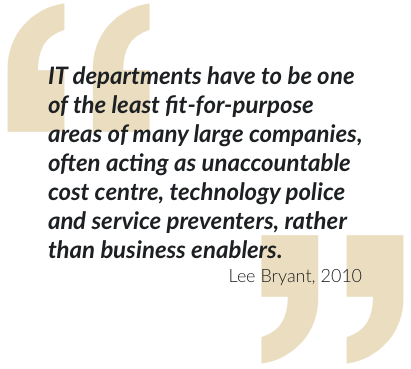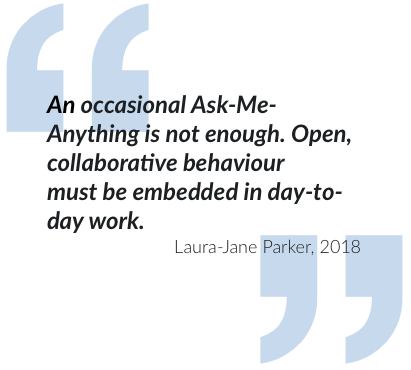Ownership
Digital Workplace Futures
How digital workplace tools are introduced into the organisation can have a substantial impact beyond initial adoption. Typically, multiple functions “own” elements of the digital workplace, and they need to work together for it to be a success. This is particularly the case during the initial roll-out, because if this lands badly or creates the wrong impressions about what people are expected to do, then it can be hard to recover.
Content, technology, support and ways of working need to be treated as part of an integrated employee experience, not divided between competing departments.
How organisations manage this and assign responsibilities for aspects of the digital workplace is often a good indicator of their digital maturity.
> Introduction
> Technology
> Ownership
> Community
> Design
> Collaboration
> Skills
> Change Agents
> Leadership
> Org Structure
> Measurement
> Conclusion
- SHIFT 1: Owned by IT
- SHIFT 2: Owned by Comms
- SHIFT 3: A Guiding Coalition
- NEXT: Broader Employee Experience Ownership?
- SHIFT 1: Owned by IT
When first launched, ownership of collaborative tools was treated like that of any organisation-wide IT system. The only ownership assigned was for the servers it would live on, the help desk resources to answer questions and the business analysts that would help ensure it was as advertised. Focus was on customisation, configuration, features and security – a tick box exercise against standard user requirements rather than any more behaviour-driven approach. This also meant that the change management that accompanied launch deployed standard click-by-click training and top-down communications. Consequently a technology-focused implementation, and neglect of the crucial human factors, led to change resistance and a general learned helplessness around the new technology.
When adoption tailed off after launch, central IT ownership led to the common misconception that the main barrier to adoption was a lack of technical knowledge amongst employees. Classic responses include basic tools training, FAQs and help desks. However, our early years on the delivery frontline taught us was that employees need to understand how tools are going to improve their day-to-day before they will commit the effort to change how they work. Central IT needed help to bring a people-centric view to the digital workplace.
- SHIFT 2: Owned by Comms
Organisations began to transfer ownership of these new tools to Internal Comms (and HR in some edge cases), creating an uncomfortable power sharing situation with IT. As two of the biggest cost centres in a large organisation, they struggled to work alongside each other, talking different languages and driven by mis-aligned KPIs.
This joint ownership arrangement came with a new perspective, and it was naturally more people-focussed, engaging advocates and guides to support adoption activities. Creative communication tactics were deployed to encourage individuals to adopt better ways of working, enlisted the help of leaders in earnest. In this shift we see the emergence of CEO blogs (carefully curated by internal communications) and executive leaders taking part in Ask Me Anything (AMA) sessions. These produced a short-term uptick of interest in the platform, and highlighted a key fundamental benefit: lateral communication and connection outside of the hierarchy.
These efforts were often run as short-term internal marketing campaigns with limited budgets. This did not create a sustainable plan for continued adoption. Chasing initial adoption and awareness through launch events, cupcakes and posters rather than helping teams find ways to embed these tools in their daily work only produced short-term success at best, and bred increased change fatigue at worst.
- SHIFT 3: Guiding Coalition
As organisations mature digitally, they recognise that digital workplace ownership must be through a guiding coalition – a collective of business area representatives that share joint responsibility for digital workplace strategy. This is often a hard-won lesson, and one which can serve as a model for managing broad, strategic work in a decentralised, distributed way.
A guiding coalition avoids a myopic project- or campaign-based approach to adoption by bringing a longer-term, never-finished view more akin to evolution than revolution. They focus on empowering teams through learning communities and sustainable peer-to-peer support approaches. They also use network dynamics and communities to drive the platform deeper, embedding it as a core system, identifying opportunities for strategic, process and use case driven change across the organisation.
A guiding coalition can only own and manage a small amount of the total change needed for digital transformation, they rely on network dynamics and influence to change broader ways of working. They cultivate a network of digital guides to be their eyes and ears, being guided by this human sensor network that sense and responds to the needs of the organisation. Sharing success and failure stories, building a system for change and continually measuring progress are all hallmarks of a digitally savvy guiding coalition focused on setting the organisation up for success.
Encouragingly, Prophet’s 2019 State of Digital Transformation Report found that over half the companies surveyed have set up this type of cross-functional group to drive meaningful change – up by 27% since 2017.
Q3: I am not a fan of all powerful CDOs – we tend to set up a digital leaders group with access to the C-suite and then use an ops group + guides network to get things done. Nobody should 'own' digital IMHO #PS_Salon
— Lee Bryant (@leebryant) April 5, 2019
We need to focus on a deep understanding of user needs in the round and end to end, not trying to solve for single tasks or sets of tasks in isolation. That means looking at integrations and the overall employee experience. #PS_Salon
— Sharon O'Dea (@sharonodea) April 5, 2019
- NEXT: Broader Employee Experience Ownership?
As the guiding coalition broadens its influence, the nexus between digital workplace and employee experience means that ownership will become even more distributed. As working/switching between information sources, workflows, communities and conversations becomes seamless in the flow, the experience of the digital workplace becomes indistinguishable from the rest of work. Then the guiding coalition will need to be influencing team leads, managers and individual employees to provide input into on-going evolutionary experience.


